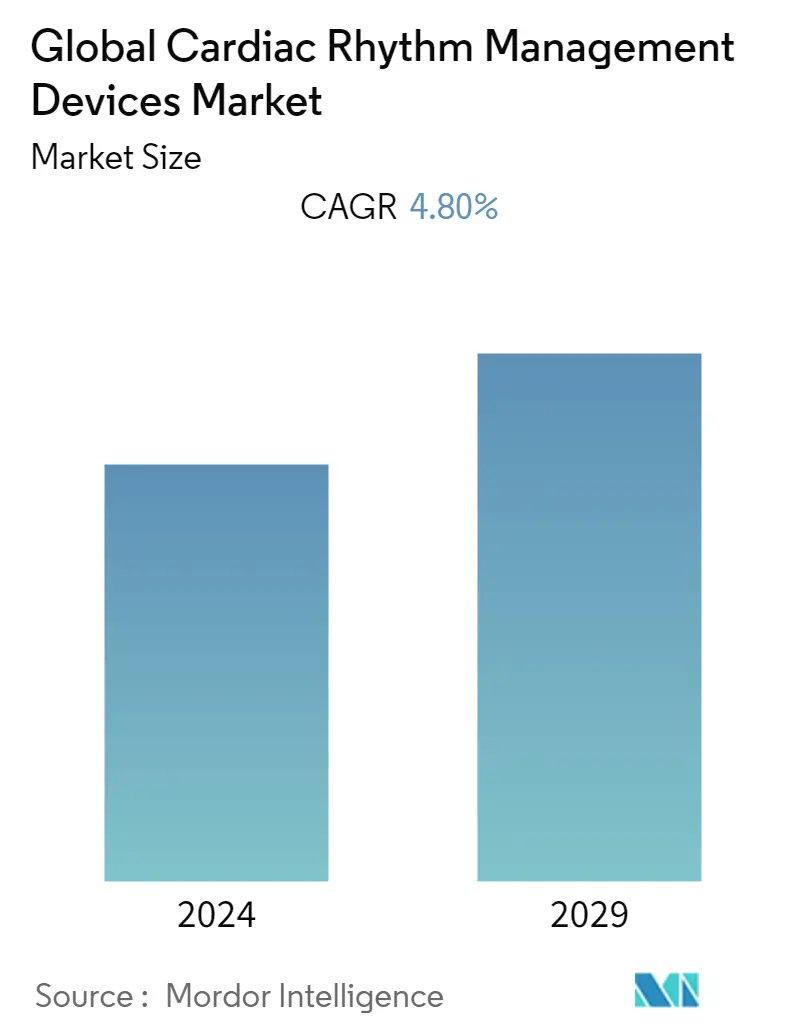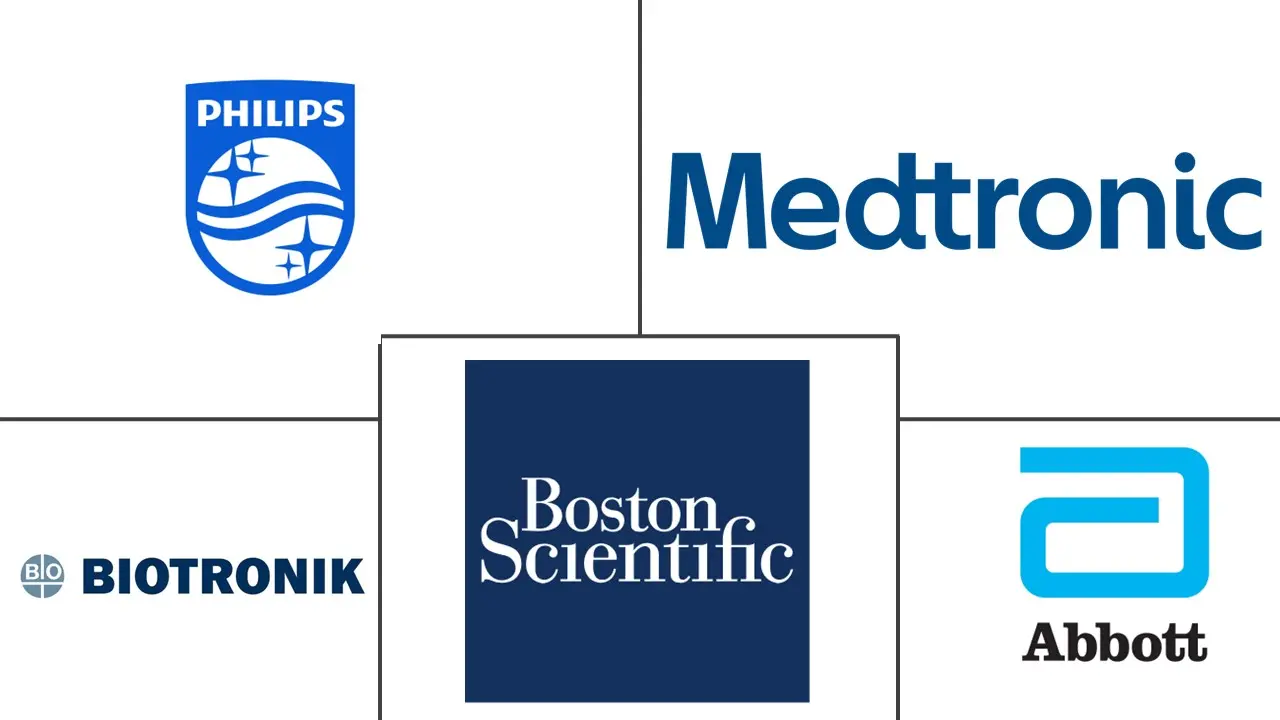Market Size of Global Cardiac Rhythm Management Devices Industry

| Study Period | 2019 - 2029 |
| Base Year For Estimation | 2023 |
| Forecast Data Period | 2024 - 2029 |
| CAGR | 4.80 % |
| Fastest Growing Market | Asia Pacific |
| Largest Market | North America |
Major Players
*Disclaimer: Major Players sorted in no particular order |
Cardiac Rhythm Management Devices Market Analysis
The cardiac rhythm management devices market is expected to witness a CAGR of 4.8% during the forecast period.
The COVID-19 pandemic led to disruption in the medical devices industry around the world which also impacted the cardiac rhythm management devices market. According to a research article by Tarun Dalia et al., published in the Indian Heart Journal in February 2021, the presence of congestive heart failure (CHF) in patients with COVID-19 is associated with increased mortality and worse outcomes. Moreover, there is an increased risk of acute cardiac injury and cardiac arrhythmia among non-survivors and severe COVID-19 patients. Therefore, the COVID-19 pandemic has been reported to cause worse outcomes in patients with underlying cardiovascular disease, especially in patients with acute cardiac injury. Therefore, the market in 2020 has been impacted by the growing COVID-19 patient pool and the rising likelihood of significantly increased risks for susceptible patients with cardiovascular disorders.
Certain factors that are driving the market growth include the increasing prevalence of cardiovascular disorders, technological advancements, a rise in the use of ambulatory and home services for cardiac monitoring, and favorable reimbursement policies. An increasing patient pool of cardiovascular diseases (CVDs) is one of the prime factors augmenting the growth of the cardiac rhythm management devices market. Sedentary lifestyles, junk food consumption, and mental stress are other key factors associated with the development of CVDs. According to the World Health Organization (WHO) data updated in June 202, cardiovascular diseases account for more than 30% of deaths worldwide. Also, nearly 33.5 million people are suffering from atrial fibrillation (AFib) globally, which is the most common type of serious arrhythmia. With the rise in the aging population in North America and Europe, the number of patients suffering from heart rhythm disorders is likely to witness an increase over the forecast period. In turn, it is expected to aid the overall market growth during the forecast period.
However, the therapeutic radiation used in cancer treatment can influence the operation of a patient with implantable cardiac rhythm devices. The implantable device technology uses complementary metal-oxide-semiconductor (CMOS) which are vulnerable to damage by the therapeutic doses of radiation, but it can vary according to the type of device in use. This factor is one of the major factors that limits the scope of using cardiac rhythm management devices, as the implants are highly sensitive and their malfunctioning may have serious consequences. On the other hand, the high cost of these devices with limited insurance coverage is limiting the growth of the market.
Cardiac Rhythm Management Devices Industry Segmentation
Cardiac rhythm management is a part of electrophysiology, which is used to manage the functioning of the heart. The last decade has observed an ongoing evolution and the use of cardiac rhythm management devices, including cardiac resynchronization therapy, pacemakers, implantable cardioverter defibrillators, and loop recorders. General practitioners (GP) are increasingly involved in the follow-up and management of patients with these devices. The Cardiac Rhythm Management Devices market is segmented by Product (Defibrillators (Implantable Cardioverter Defibrillators (ICDS) and External Defibrillators (ED)), Pacemakers (Implantable Pacemakers (ICPS) and External Pacemakers), and Cardiac Resynchronization Therapy Devices (Cardiac Resynchronization Therapy Defibrillators (CRT-D) and Cardiac Resynchronization Therapy Pacemakers (CRT-P))), and Geography (North America, Europe, Asia-Pacific, Middle East and Africa, and South America). The market report also covers the estimated market sizes and trends for 17 different countries across major regions, globally. The report offers the value (in USD million) for the above segments.
| By Product | ||||
| ||||
| ||||
|
| Geography | ||||||||
| ||||||||
| ||||||||
| ||||||||
| ||||||||
|
Global Cardiac Rhythm Management Devices Market Size Summary
The cardiac rhythm management devices market is poised for steady growth, driven by an increasing prevalence of cardiovascular disorders and technological advancements in the field. The market has faced challenges due to the COVID-19 pandemic, which disrupted the medical devices industry and highlighted the vulnerabilities of patients with underlying cardiovascular conditions. Despite these challenges, factors such as the rise in ambulatory and home services for cardiac monitoring and favorable reimbursement policies are contributing to market expansion. The aging population in regions like North America and Europe is expected to further boost the demand for these devices, as more individuals are likely to suffer from heart rhythm disorders. However, the market faces limitations due to the high cost of devices, limited insurance coverage, and the sensitivity of implantable devices to therapeutic radiation used in cancer treatments.
North America is anticipated to hold the largest market share, supported by a developed healthcare infrastructure and government initiatives addressing the rising burden of cardiovascular diseases. The region's dominance is further reinforced by the increasing incidence of heart disease, driven by factors such as obesity and unhealthy lifestyles. The competitive landscape of the market is characterized by strategic initiatives from key players like Abbott, Medtronic, and Boston Scientific, who are engaging in collaborations, product launches, and acquisitions to enhance their market presence. Innovations such as Abbott's leadless pacemaker and Medtronic's transcatheter pacing system are indicative of the ongoing advancements in cardiac rhythm management technologies. These developments, coupled with the growing demand for effective cardiac monitoring and treatment solutions, are expected to sustain the market's growth trajectory over the forecast period.
Global Cardiac Rhythm Management Devices Market Size - Table of Contents
-
1. MARKET DYNAMICS
-
1.1 Market Overview
-
1.2 Market Drivers
-
1.2.1 Increasing Prevalence of Cardiovascular Disorders
-
1.2.2 Technological Advancements
-
1.2.3 Rise in the Use of Ambulatory and Home Services for Cardiac Monitoring
-
-
1.3 Market Restraints
-
1.3.1 Effects of Therapeutic Radiation on Implantable Cardiac Rhythm Devices
-
1.3.2 High Cost of Devices
-
-
1.4 Porter's Five Forces Analysis
-
1.4.1 Threat of New Entrants
-
1.4.2 Bargaining Power of Buyers/Consumers
-
1.4.3 Bargaining Power of Suppliers
-
1.4.4 Threat of Substitute Products
-
1.4.5 Intensity of Competitive Rivalry
-
-
-
2. MARKET SEGMENTATION (Market Size by Value - USD million)
-
2.1 By Product
-
2.1.1 Defibrillators
-
2.1.1.1 Implantable Cardioverter Defibrillators (ICDS)
-
2.1.1.2 External Defibrillators (ED)
-
-
2.1.2 Pacemakers
-
2.1.2.1 Implantable Pacemakers (ICPS)
-
2.1.2.2 External Pacemakers
-
-
2.1.3 Cardiac Resynchronization Therapy Devices
-
2.1.3.1 Cardiac Resynchronization Therapy Defibrillators (CRT-D)
-
2.1.3.2 Cardiac Resynchronization Therapy Pacemakers (CRT-P)
-
-
-
2.2 Geography
-
2.2.1 North America
-
2.2.1.1 United States
-
2.2.1.2 Canada
-
2.2.1.3 Mexico
-
-
2.2.2 Europe
-
2.2.2.1 Germany
-
2.2.2.2 United Kingdom
-
2.2.2.3 France
-
2.2.2.4 Italy
-
2.2.2.5 Spain
-
2.2.2.6 Rest of Europe
-
-
2.2.3 Asia-Pacific
-
2.2.3.1 China
-
2.2.3.2 Japan
-
2.2.3.3 India
-
2.2.3.4 Australia
-
2.2.3.5 South Korea
-
2.2.3.6 Rest of Asia-Pacific
-
-
2.2.4 Middle East and Africa
-
2.2.4.1 GCC
-
2.2.4.2 South Africa
-
2.2.4.3 Rest of Middle East and Africa
-
-
2.2.5 South America
-
2.2.5.1 Brazil
-
2.2.5.2 Argentina
-
2.2.5.3 Rest of South America
-
-
-
Global Cardiac Rhythm Management Devices Market Size FAQs
What is the current Global Cardiac Rhythm Management Devices Market size?
The Global Cardiac Rhythm Management Devices Market is projected to register a CAGR of 4.80% during the forecast period (2024-2029)
Who are the key players in Global Cardiac Rhythm Management Devices Market?
Abbott, Biotronik SE & Co KG, Boston Scientific Corporation, Medtronic PLC and Koninklijke Philips NV are the major companies operating in the Global Cardiac Rhythm Management Devices Market.

